Virus-X Debate Round 1
His First Post
Click here to see the corresponding thread on the forums.
[Editor's note: this was sent in reply to the following excerpt from an E-mail sent Thu, 20 Nov 2003 23:37:50 -0500, which was in turn sent as a response to his message saying "Ok, while I've got a few minutes, let's hear your take on the display of firepower in "The Die is Cast", and "The Empire Strikes Back" (since he apparently thought it was unreasonable of me to simply ask that he read my website):
1) TDiC demonstrates sufficient Trek firepower to cause less destruction at surface level than a large asteroid strike, with non-persistent fireballs, no visible ejecta whatsoever, and in fact, less surface luminosity than is generated from a large forest fire. In fact, the ONLY evidence that the ships in orbit were capable of anything more than surface-level destruction was one of several possible interpretations of a piece of dialogue, which is to say no conclusive evidence at all. Contrast this to their various attempts to destroy asteroids in "Rise" and "Pegasus" and "Cost of Living", which are consistent with their observed firepower in TDiC but not with the unreasonable extrapolations derived from optimistic interpretations of dialogue that are common to wild-eyed Trekkie fanatics.
2) The common use of TESB as a maximum benchmark (rather than a ridiculously conservative lower limit) for Imperial firepower is actually a joke in light of the fact that Slave-1 was effortlessly pulverizing multi-kilometre wide asteroids in AOTC. It's precisely analogous to saying that you saw an M1 Abrams' 120mm smoothbore punch through drywall, so you're going to take that as a firepower limit for a 120mm smoothbore even though a comparatively miniscule handgun can do the same thing, and the published specs for a 120mm smoothbore are much higher. Having said that, the calculations show that it takes around a third of a megaton to vape one of those asteroids as shown, although ISD guns are actually much more powerful than that.
His response (and first post of the debate) follows:
Received Wed, 26 Nov 2003 13:30:01 GMT
1) TDiC demonstrates sufficient Trek firepower to cause less destruction at surface level than a large asteroid strike, with non-persistent fireballs, no visible ejecta whatsoever, and in fact, less surface luminosity than is generated from a large forest fire. In fact, the ONLY evidence that the ships in orbit were capable of anything more than surface-level destruction was one of several possible interpretations of a piece of dialogue, which is to say no conclusive evidence at all. Contrast this to their various attempts to destroy asteroids in "Rise" and "Pegasus" and "Cost of Living", which are consistent with their observed firepower in TDiC but not with the unreasonable extrapolations derived from optimistic interpretations of dialogue that are common to wild-eyed Trekkie fanatics.
You're attempting to use special effects as a barometer, when, if you're as intelligent as you say you are, you'd know that that isn't always possible. Generally, however, you are more than willing to take the special effects of the Star Wars series as teaching and learning tools, and more than willing to exclude Trek's effects to keep your double-standard going. I interpret the massive explosions completely differently, and you can insult me all you wish, but it will be just as meaningless as trying to dispute the events through a mere complaint.
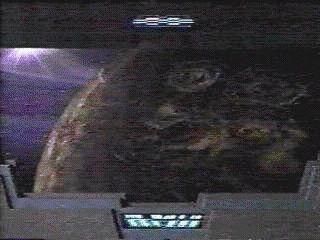
The viewer image is the favorite image of the anti-Trek side, depicting the fading of several massive explosions, once the bombardment of only a handful of seconds had concluded. Here, you can already see the shockwaves spreading out across the planet, thanks to Romulan plasma torpedoes & disruptor cannons, alongside Cardassian phaser cannons. The explosions are clearly massive. In addressing: "...less destruction at surface level than a large asteroid strike," not too many "...large asteroid..." strikes render "30% Of the planetary crust destroyed in opening volley..." ("The Die is Cast", Episode No: 467, Air Date: 05.01.1995, Stardate: Unknown). Below is a picture with red lines to enhance and more clearly define the diameter and radii of the explosions, the largest of which coming from a Romulan plasma torpedo detonation.
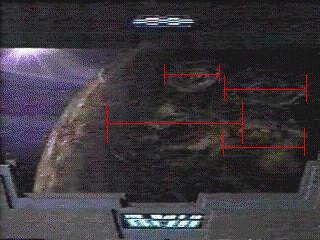
"... with non-persistent fireballs, no visible ejecta whatsoever ..."
Fiery mushroom clouds do not form, immediately upon detonation. They are the result of the implosion, as flaming debris is brought back in to ground zero, where it collides and goes upwards into the air, along with tons of soil. The fiery bursts seen more closely resemble Wilson Clouds.
Ok. Going against a world that was, again, ~12,734 km/7,926.385 miles in diameter, the area of effect that the Romulan torpedo explosion fireballs covered was ~±35% planetary diameter, or ~4,456.9 km/~2,763.278 mi. in diameter. The measurement is based on the fact that the Founders' World is listed as being Earth-like.
Founders' homeworld. Sunless Class-M planet located somewhere in the Omarian Nebula in the Gamma Quadrant. The planet was the home of the reclusive civilization of shape-shifters known as the Founders and the central planet of the Dominion. ("The Search, Part 1" [DS9]). In 2371, the Tal Shiar and Obsidian Order launched a massive attack against the Founders' homeworld, bombarding the planet's surface with a fleet of 20 starships. Neither attacker realized that the Founders had evacuated the planet, or that they had a fleet of 150 Jem'Hadar ships waiting to destroy the invaders. ("The Die is Cast" [DS9]. SEE: Lovok, Colonel; Tain, Enabran.
It should be noted that while the shockwave was clearly visible as a blast-front, what was mostly visible was the gigantic fireball, however, both pieces of visual evidence must be examined carefully and objectively. A fireball doesn't, ordinarily, spread out that quickly, though the shockwave can through superheated air. Something moving that quickly and being fiery as it was could only be one thing: a Wilson Cloud. Remember: Preceding the actual fireball, in some instances, is the formation of what could be a gigantic "condensation cloud', or "Wilson Cloud' (so-called, due to it's being analogous to those created by scientists in the Wilson Cloud Chamber, back in the 20th century). With the detonation of a nuclear weapon, there is the passage of a supersonic, high-pressure shock front through the air, which, in turn, is followed by a rarefaction (or suction) wave. During the blast (called the compression phase), air temperatures rise, and, during the decompression (or the suction phase), it falls. Moderately low blast pressures can have temperature drops falling below it's original, pre-shock value, so that if the air contains a fair amount of water vapor, condensation accompanied by the formation of a cloud occurs. Back in 1946 during the ABLE Test at Bikini, a thermonuclear warhead was detonated. Since the device had been detonated just above the surface of a lagoon, the air was near-saturated with water vapor and the conditions were more than suitable for the formation of the Wilson Cloud. In photographs, it is clearly seen that the Wilson Cloud formed some distance ahead of the fireball. The reason was due to the shock front's travelling a considerable distance, before the blast pressure had fallen sufficiently to allow a low temperature to be attained in the following decompression phase. By the time the temperature had dropped far enough as was required for condensation to occur, the blast wave front had moved even further away, and could even be seen where the disk-like formation on the surface of the water indicated the passage of the shockwave. When there's relatively high humidity (such as over or under water), as with the famous Bikini tests of 1946, conditions for seeing a nuclear Wilson Cloud are very favorable, and forms about 1-2 seconds after detonation. However, about 1-2 seconds later, after the air had begun warming up, the condensation cloud disappears. They can appear dome-shaped, and change shape (such as into rings), as they disappear. Wilson Clouds appear after the fireball has emitted most of it's thermal rays, so it really doesn't have any effect on this radiation, while it is simultaneously true that fairly thick cloudcover can attenuate thermal rays from reaching the earth from the fireball. Also, when considering the surface was "...destroyed...", there is very little reason to expect to see your "...visible ejecta...". There were no significant structures on the surface (such as large buildings), and plasma torpedoes would probably completely incinerate into vaporization anything they destroy. The Cardassian phasers were on unknown settings, but, if they were at full power and similar to those of UFP Starfleet phasers, fragments would be exceedingly small. Let's also not forget the fact that this was being viewed from hundreds upon of hundreds of kilometers of distance; probably highest orbit.
"In fact, the ONLY evidence that the ships in orbit were capable of anything more than surface-level destruction was one of several possible interpretations of a piece of dialogue, which is to say no conclusive evidence at all."
Patently untrue. There is absolutely nothing ambiguous about "30% Of the planetary crust destroyed in opening volley." Any such ambiguities that could possibly be there were injected by Star Wars zealots that were disappointed in the fact that they were finally, decisively and conclusively whipped by their whipping boy, Star Trek. There is no reason to try running off to interpret "...30% Of the planetary crust destroyed in opening volley..." in any other way than it was said, except by those attempting obfuscation of the obvious facts through smoke-screening. From the official Star Trek website (www.startrek.com), their synopsis is equally direct:
Episode No: 467
Air Date: 05.01.1995
Stardate: Unknown
The Die Is Cast
Synopsis
After rejoining his former Cardassian mentor, Enabran Tain, Garak helps him in a joint mission with the Obsidian Order and the Romulan Tal Shiar. Tain has masterminded a plan to destroy the Founders — Odo's people, who rule the Dominion — and their homeworld. Tain, along with Colonel Lovok of the Tal Shiar, leads a fleet of cloaked Romulan and Cardassian ships into the Gamma Quadrant, commanding them from their Romulan Warbird. Garak is told to question Odo, who is being held prisoner aboard Tain's ship. However, Odo says he knows none of his people's secrets. On the station, Sisko learns of Tain's mission, and is warned by Starfleet's Admiral Toddman to prepare for retaliatory attacks by the Jem'Hadar.
Fearing Odo is aboard one of the Romulan ships, Sisko and his officers, including Security Chief Eddington, defy a direct order from Toddman and take the Defiant into the Gamma Quadrant to search for Odo. Soon afterward, the ship suddenly and inexplicably decloaks, leaving them vulnerable to attack by the Jem'Hadar, the Dominion's soldiers. Meanwhile, as Tain, Garak, and Lovok head for the Founders' planet, Tain urges Garak to interrogate Odo and learn if his people have a secret defense system. Garak agrees, but finds himself conflicted.
On the Defiant, Eddington confesses to sabotaging the cloaking device, under orders from Toddman to prevent pursuit of Tain's fleet. Back at the Romulan ship, Garak interrogates Odo using a device that prevents him from changing his shape. Odo insists he is not hiding anything, but Garak persists, and Odo begins to literally dry up and fall apart. Unable to watch Odo's excruciating agony, Garak begs him to talk, and Odo reveals his secret — he wants to rejoin his people. Shaken, Garak deactivates the device and lets Odo finally morph into liquid form.
Garak claims that Odo knows nothing, and Tain orders Odo killed. However, Lovok and Garak convince him to spare Odo for later Romulan study. The fleet then reaches the Founders' planet and opens fire, destroying part of the surface, but there is no change in the life form readings. Garak discovers their ships have been lured into a trap — the planet is actually deserted. As he explains, their vessels are suddenly surrounded by 150 Jem'Hadar ships.
The Jem'Hadar attack, and Garak takes advantage of the chaos to escape and rescue Odo. Surprisingly, Lovok helps them get to their Runabout and reveals he is actually one of the Founders. His people learned of Tain's plan and encouraged it in order to bait the Obsidian Order and Tal Shiar into annihilation. Lovok tries to convince Odo to return home, but he refuses. Forced to leave behind Tain, Odo and Garak escape on their ship, and the Defiant rescues them from the Jem'Hadar assault. The Romulan/Cardassian fleet is destroyed as the crew returns to the Alpha Quadrant, barely escaping with their lives.
The sentence stating: "The fleet then reaches the Founders' planet and opens fire, destroying part of the surface," very well reinforces the Romulan bridge officer's analysis: "30% Of the planetary crust destroyed in opening volley." Like I've already said, any so-called and alleged ambiguities are manufactured by those that have wild eyes that they keep shut, as is the case when dealing with the average Star Wars absurdist.
"Contrast this to their various attempts to destroy asteroids in "Rise"..."
In the episode "Rise" (Star Trek: Voyager, episode 60, teleplay by Brannon Braga, story by Jimmy Diggs, directed by Robert Scheerer), it was stated quite clearly that Voyager's firepower was more than adequate to destroy the asteroid, and it was treated as a mystery as to why they didn't. Had you taken to time to further elaborate, you should've brought up the fact that the asteroids were, in fact, artificial. These asteroids of yours were revealed to be weapons of mass destruction, used to pummel planets into submission and destruction. Furthermore, these asteroids should've been destroyed. In fact, not only destroyed, but vaporized, as the script clearly reveals:
Janeway: "Fire."
Tuvok: "The asteroid is fragmenting. But, most of the debris is still on a collision course with the planet."
Janeway: "Target the fragments. Destroy them."
Chakotay: "That asteroid should have been vaporized. What happened?"
Kim: "I'm not sure. Sensors showed a simple nickel-iron composition. We shouldn't be seeing fragments more than a centimeter in diameter."
(Sklar tells of the similar outcome of their own efforts on previous asteroids.)
Tuvok: "I've destroyed most of the debris, Captain. However, targeting scanners were unable to track two of the fragments. They have already entered the upper atmosphere.
(Tuvok's report comes at 1:10 in the episode, 28 seconds after the asteroid was first hit, and 20 seconds after Janeway's order to destroy the fragments.)
Four minutes into the episode, we learn something interesting from a Nisu scientist named Vadum, "our most prominent astrophysicist," as per the Ambassador's statements.
Vadum: "Ambassador, I've been analyzing the debris, and I've discovered disturbing evidence that the asteroids are not what they seem! They are composed of artificial materials. I must meet with you immediately . . ." (garbling, then transmission cuts out)
Courtesy of http://www.st-v-sw.net/STSWrise.html
Then, the same episode further clarifies that the asteroids had an anomalous physical composition:
Torres: "I've completed the mineralogical scans. The rock is composed of trioxine, olivine, . . . waitaminute. I'm reading a concentration of triatium."
Ambassador: "Triatium? Isn't that an alloy?"
Torres: "Yes."
Chakotay: "B'Elanna, give me a hand with this."
(Chakotay has used a pick to crack the outer layer. He and Torres now pull the two pieces apart, revealing the rock's technology-innards.)
Torres: "This doesn't look like any asteroid I've ever seen, but I'll bet it's the source of our triatium."
Courtesy of http://www.st-v-sw.net/STSWrise.html
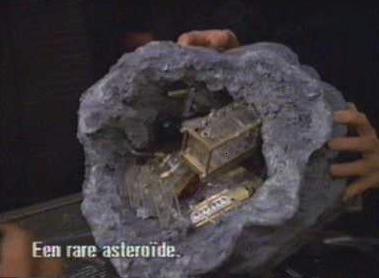
The
asteroid fragment in question.
Commonly, Star Wars zealots fail to point out that the concentration and heat of vaporization of triatium is completely unknown, and, is quite probably fairly high. How large was this asteroid?
From here, scaling the torpedo is a simple matter. For the sake of being conservative, I will assume that Voyager's torpedo is fired in a portward direction (i.e. toward the observer) . . . this will have the effect of making the torpedo glow area smaller. It should be noted that it is pretty clear from the episode that Voyager was shooting roughly dead-ahead. However, making the torpedo appear to be smaller will have the effect of making the asteroid seem smaller, making this a conservative estimate.
Scaling off of Voyager's port side, and using the torpedo as it appeared two frames after being fired, the central glowing area of the torpedo (i.e. not including the streamers) is approximately 10 meters in diameter. Now, I shall take the asteroid as it appeared two frames before torpedo impact (image below). (The image one frame before impact shows an illumination of the asteroid surface, and I do not want my estimate thrown off as a result). I count the torpedo as being a grand total of four pixels wide, with the central glowing area constituting two pixels or so of width. The asteroid is sitting at an angle of about 45 degrees in the shot . . . tipping it so the long axis is vertical, we have an asteroid length of 78 pixels, with a width varying between 37 and 50 pixels. I shall treat the asteroid as if it were a rough cylinder.
If one pixel equals five meters, this gives the asteroid an approximate length of 390 meters, with a width varying between 185 and 250 meters.
Courtesy of http://www.st-v-sw.net/STSWrise.html
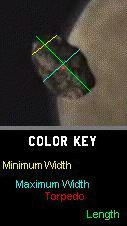
That's a pretty big asteroid. Utilizing similar methodologies, you came up with your own estimate for asteroid sizes in Episode 4, and none of the destroyed asteroids were estimated to be anywhere near approximate to "...390 meters, with a width varying between 185 and 250 meters."
"...and "Pegasus"..." This is another manifest un-truth. Your implication that they lacked the power to destroy the asteroid in which the Galaxy-class Enterprise had been trapped is a lie, as the script plainly states:
"The asteroid's internal structure is highly unstable. Any attempt to cut through the rock could cause the entire chasm to collapse."
This was spoken by whom you call "...the supposedly infallible Data ...".
As for the episode "Cost of Living", most Star Wars absurdists and zealots deftly avoid a description given as to the material composition of the asteroid in question. Why? Because it was composed of unknown substances that had an unknown heat of vaporization and level of durability. Let's take a look:
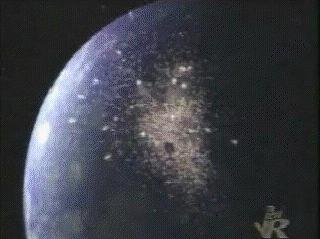
Photon
torpedo strike against asteroid as Enterprise pursues.
"Note also that the "Rise" asteroid is not the largest asteroid we've seen destroyed by torpedoes, or the densest. "Cost of Living"[TNG] shows the Enterprise-D using two torpedoes to destroy an asteroid, and the first torpedo is not even visible for most of the second torpedo's trip.
"This asteroid is shattered, not vaporized. The asteroid was large enough, however, to have a differentiated core composed of "densely compressed nitrium and chrondite", and the remaining core was of sufficient size and density to cause planetwide damage to the planet below. Even if we merely assume a 10-15 megaton blast similar to Tunguska, that's still an asteroid of tremendous size, tremendous density, or both (at somewhat less tremendous levels). Data concluded that another torpedo would be unlikely to damage the core, but was able to shatter the core with a technobabble particle beam from the deflector. Judging by the beam, the core remnant was the size of the secondary hull of the Enterprise. The remaining core fragments no longer posed a danger, and were then flown through by the Enterprise on her way out of the system: "
- Courtesy of http://www.st-v-sw.net/STSWrise.html
What do you know about nitrium?
Nitrium. A metal alloy used in the construction of Federation starships. Nitrium is used in the interior construction of such ship's systems as inertial dampening field generators, power transfer conduits, and the matter/antimatter reaction chamber. ("Cost of Living" [TNG]).
-Star Trek Encyclopedia, a Reference Guide to the Future (Updated and Expanded Edition), "Nitrium", pg.: 325. Written by Michael Okuda and Denise Okuda, with Debbie Mirek.
You are quick to assume everything in favor of Star Wars, but always quick to try to double-standard it against Star Trek, but, that's to be expected from someone that says they're biased against Star Trek. This is further evidenced by such dismissive insults as "...not with the unreasonable extrapolations derived from optimistic interpretations of dialogue that are common to wild-eyed Trekkie fanatics...", which is merely an attempt to pre-emptively discredit and dismiss perfectly valid points.
2) The common use of TESB as a maximum benchmark (rather than a ridiculously conservative lower limit) for Imperial firepower is actually a joke in light of the fact that Slave-1 was effortlessly pulverizing multi-kilometre wide asteroids in AOTC. It's precisely analogous to saying that you saw an M1 Abrams' 120mm smoothbore punch through drywall, so you're going to take that as a firepower limit for a 120mm smoothbore even though a comparatively miniscule handgun can do the same thing, and the published specs for a 120mm smoothbore are much higher. Having said that, the calculations show that it takes around a third of a megaton to vape one of those asteroids as shown, although ISD guns are actually much more powerful than that.
This paragraph was, quite frankly, a waste of time to even compose, though I do agree with you that turbolasers mounted on Imperial and Imperial II class star destroyers are far more powerful than megaton, more accurately being in the range of ~418(1018) J/100 gigatons of TNT. In any event, if neither of the asteroid field scenes were considered benchmarks, what is? The Death Star certainly isn't, because superlasers aren't mounted on most ships, with the obvious exceptions of the Eclipse and Sovereign classes (both of which were less powerful than the superlaser mounted on the original Death Star).
Virus-X (ver 7.0)
FromBFECanton@hotmail.com